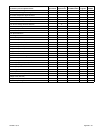TP-6200 10/12 Appendix 205
135 amps = ( 112500 / 3) / 277
Where: acos is arccosine or inverse cosine
W is Watt
L-N is line-to-neutral
PF is power factor
VA is volt-ampere
k is kilo ( = 1000 )
Therefore, each generator set in this case should carry
113 amps per phase or half the 226 calculated line
amps. The 113 amps includes 67.5 amps of reactive
current, half of the calculated reactive current of
135 amps. The reactive droop should be adjusted until
each generator set carries equal reactive current. The
load sharing control should be adjusted s o that real
current and/or watts are shared equally as well.
If one generator set is larger than the other, it should be
adjusted to carry proportionate current. For this
example, if a 150 kW generator set is paralleled to a
75 kW generator set, the larger generator set would
carry 90 amps reactive (135 * 2 / 3) and the other would
carry 45 amps reactive (135 * 1 / 3). Adjust the reactive
droop based on the ratio of the actual measured
currents, not the calculated values.
VAR Control
VAR control is analogous to the reactive droop function
described above. It differs in that it applies to utility
paralleling applications. Because the utility represents a
nearly infinite bus, the voltage at the load terminals is not
controlled at all by the generator set, and it is impossible
to compare the ratio of the generator set current to the
utility based on its rated output. In this situation, the
excitation control changes from voltage feedback to
VAR feedback. More specifically, the excitation is
controlled to maintain a certain VAR output rather than a
voltage output. This is called VAR control and again is
used only in utility paralleling applications.
The VAR adjust can be set to any value within the
generator set’s rated capability. Because the VARs
cause heating in the armature, any value beyond the
generator set’s rating could damage the alternator. In
most cases, the generator set will be adjusted to
generate VAR (lagging PF) but could absorb VARs
(leading PF) as well. However, the VAR setting is
maintained regardless of the relative PF. If the particular
load requires more VARs than the generator set setting,
the excess is derived from the utility bus.
The term rated VARs is a bit obscure. In essence, it is a
value derived from the rated kW of the generator set. For
a typical standby rating, the full load of the generator set
is defined to have 0.8 PF. This means that the kW load is
eight-tenths of the VA load. As described earlier, the PF
for a linear load may be calculated as the cosine of the
angle between voltage and current. This relationship is
based on the power triangle. Using this power triangle
concept, it can be shown that the reactive power for a
linear load is equal to the sine of the power angle. Then,
using these trigonomic functions, it can be shown that for
a PF of 0.8, the VARs are related similarly to the VA by a
factor of 0.6. More explicitly, the power angle is equal to
the inverse cosine (arccosine) of the PF. For a PF of 0.8,
the power angle is 36.9 degrees (0.2 radians). The sine
of this angle, sine (36.9 degrees) is 0.6. This is the factor
for calculating rated VARs from the rated VA. The ratio of
these two factors is 0.75 (0.6 / 0.8), which can be used to
calculate rated VARs directly from the rated kW; rated
VARs equals rated watts * 0.75.
When a generator set will be connected in parallel with
the utility, VAR or PF control should be ENABLED. If
multiple generator sets are in parallel as well, then
reactive droop should be ENABLED also. Additionally,
note that VAR control should be used only when the
generator set is connected in parallel with the utility.
Parallel connection with the utility requires the logical
indication that the circuit breakers tying the generator
set bus to the utility bus are closed. This indication is
made by use of the programmable digital input for
VAR/PF mode. If this input function is activated, the
excitation control changes to the selected VAR or PF
control. If the logical indicator is not present and the VAR
or PF control is not enabled, the control will not switch to
VAR or PF control. Because the active state for the
digital input is a HI or open connection, the default for the
digital input (VAR/PF Mode) is DISABLED (displays
ENABLED NO). If the input is ENABLED by the user, it
should be held low by a contact or jumper until the actual
closing of the connecting circuit breaker(s). The proper
control method, VAR or PF, must be ENABLED within
the regulator’s configuration menu.
Power Factor Control
PF control is much like the VAR control above. PF
control is used only when the generator set is paralleled
to the utility grid. The difference is that the PF of the
generator set current is held constant. The setting for
the PF adjust determines the relationship of the current
and voltage from the generator set. The PF is a term that
defines the ratio of real watts to the volt-ampere (VA)
product. For linear loads, a trigonomic relationship can
describe the PF. The PF equals the cosine of the angle
between the current and voltage. PF is further defined
as leading or lagging. That is to say, if the c urrent lags
the voltage (i.e., is later in time), the PF is lagging; if the
current leads the voltage (i.e., is earlier in time), the PF is
leading. Inductive loads have lagging PF while
capacitive loads have leading PF. The current in a
purely resistive load is in phase with the voltage (not
leading or lagging) and the PF is 1.0 (cos. [0]).


















